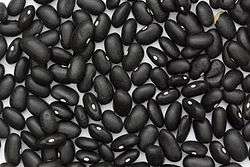Black turtle bean
 | |
| Nutritional value per 100 g (3.5 oz) | |
|---|---|
| Energy | 552 kJ (132 kcal) |
|
23.71 | |
| Sugars | 0.32 |
| Dietary fiber | 8.7 |
|
0.54 | |
| Saturated | 0.139 |
| Trans | 0 |
| Monounsaturated | 0.047 |
| Polyunsaturated | 0.231 |
|
8.86 | |
| Vitamins | |
| Vitamin A equiv. |
(0%) 0 μg |
| Vitamin A | 6 IU |
| Thiamine (B1) |
(21%) 0.244 mg |
| Riboflavin (B2) |
(5%) 0.059 mg |
| Niacin (B3) |
(3%) 0.505 mg |
| Vitamin B6 |
(5%) 0.069 mg |
| Folate (B9) |
(37%) 149 μg |
| Vitamin B12 |
(0%) 0 μg |
| Vitamin C |
(0%) 0 mg |
| Vitamin D |
(0%) 0 μg |
| Vitamin D |
(0%) 0 IU |
| Vitamin E |
(6%) 0.87 mg |
| Vitamin K |
(3%) 3.3 μg |
| Minerals | |
| Calcium |
(3%) 27 mg |
| Iron |
(16%) 2.10 mg |
| Magnesium |
(20%) 70 mg |
| Phosphorus |
(20%) 140 mg |
| Potassium |
(8%) 355 mg |
| Sodium |
(16%) 237 mg |
| Zinc |
(12%) 1.12 mg |
| Other constituents | |
| Water | 65.74 g |
| |
|
Percentages are roughly approximated using US recommendations for adults. Source: USDA Nutrient Database | |
The black turtle bean is a small, shiny variety of common beans (Phaseolus vulgaris), especially popular in Latin American cuisine, though it can also be found in Cajun and Creole cuisines of south Louisiana. Black beans (and all common beans) are native to the Americas, but have been introduced around the world. They are also used in Punjabi cuisine. In Punjabi, they are known as maa ki daal, but are used interchangeably with vigna mungo in countries such as the USA . They are often called simply black beans (frijoles negros, zaragoza, judía negra, poroto negro, caraota o habichuela negra in Spanish, and feijão preto in Portuguese), although this can cause confusion with other black beans.
Background
The black turtle bean has a dense, meaty texture, which makes it popular in vegetarian dishes, such as frijoles negros and the Mexican-American black bean burrito. It is a very popular bean in various regions of Brazil, and is used in the national dish, feijoada. It is also a main ingredient of Moros y Cristianos in Cuba, is a must-have in the typical gallo pinto of Costa Rica and Nicaragua, is a fundamental part of pabellón criollo in Venezuela, and is served in almost all of Latin America, as well as many Hispanic enclaves in the United States. In the Dominican Republic cuisine, it is also used for a variation of the Moros y Cristianos simply called Moro de habichuelas negras. The black turtle bean is also popular as a soup ingredient. In Cuba, black bean soup is a traditional dish, usually served with white rice.
It is also common to keep the boiled water of these beans (which acquires a black coloring) and consume it as a soup with other ingredients for seasoning (known as sopa negra, black soup), as a broth (caldo de frijol, bean broth) or to season or color other dishes (aforementioned gallo pinto, for example).
Samples of black turtle beans were reported in 2006 to contain total anthocyanins in their dried seed coats of 0−2.78 mg/g.[2]
Varieties
Black turtle bean varieties (cultivars) include:
- 'Black Magic'
- 'Blackhawk'
- 'Domino'
- 'Nighthawk'
- 'Valentine'
- 'Zorro'
References
External links
| Wikimedia Commons has media related to Black turtle bean. |